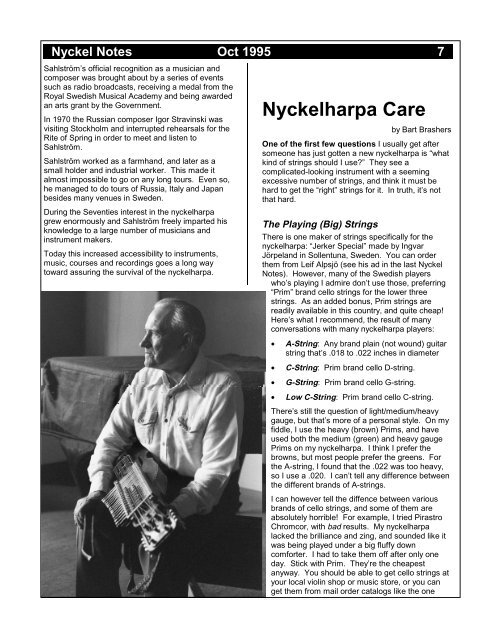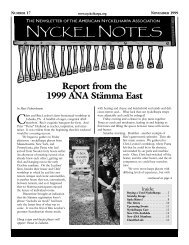Download Number 2 - American Nyckelharpa Association
Download Number 2 - American Nyckelharpa Association
Download Number 2 - American Nyckelharpa Association
You also want an ePaper? Increase the reach of your titles
YUMPU automatically turns print PDFs into web optimized ePapers that Google loves.
Nyckel Notes Oct 1995 7<br />
Sahlström’s official recognition as a musician and<br />
composer was brought about by a series of events<br />
such as radio broadcasts, receiving a medal from the<br />
Royal Swedish Musical Academy and being awarded<br />
an arts grant by the Government.<br />
In 1970 the Russian composer Igor Stravinski was<br />
visiting Stockholm and interrupted rehearsals for the<br />
Rite of Spring in order to meet and listen to<br />
Sahlström.<br />
Sahlström worked as a farmhand, and later as a<br />
small holder and industrial worker. This made it<br />
almost impossible to go on any long tours. Even so,<br />
he managed to do tours of Russia, Italy and Japan<br />
besides many venues in Sweden.<br />
During the Seventies interest in the nyckelharpa<br />
grew enormously and Sahlström freely imparted his<br />
knowledge to a large number of musicians and<br />
instrument makers.<br />
Today this increased accessibility to instruments,<br />
music, courses and recordings goes a long way<br />
toward assuring the survival of the nyckelharpa.<br />
<strong>Nyckelharpa</strong> Care<br />
by Bart Brashers<br />
One of the first few questions I usually get after<br />
someone has just gotten a new nyckelharpa is “what<br />
kind of strings should I use?” They see a<br />
complicated-looking instrument with a seeming<br />
excessive number of strings, and think it must be<br />
hard to get the “right” strings for it. In truth, it’s not<br />
that hard.<br />
The Playing (Big) Strings<br />
There is one maker of strings specifically for the<br />
nyckelharpa: “Jerker Special” made by Ingvar<br />
Jörpeland in Sollentuna, Sweden. You can order<br />
them from Leif Alpsjö (see his ad in the last Nyckel<br />
Notes). However, many of the Swedish players<br />
who’s playing I admire don’t use those, preferring<br />
“Prim” brand cello strings for the lower three<br />
strings. As an added bonus, Prim strings are<br />
readily available in this country, and quite cheap!<br />
Here’s what I recommend, the result of many<br />
conversations with many nyckelharpa players:<br />
• A-String: Any brand plain (not wound) guitar<br />
string that’s .018 to .022 inches in diameter<br />
• C-String: Prim brand cello D-string.<br />
• G-String: Prim brand cello G-string.<br />
• Low C-String: Prim brand cello C-string.<br />
There’s still the question of light/medium/heavy<br />
gauge, but that’s more of a personal style. On my<br />
fiddle, I use the heavy (brown) Prims, and have<br />
used both the medium (green) and heavy gauge<br />
Prims on my nyckelharpa. I think I prefer the<br />
browns, but most people prefer the greens. For<br />
the A-string, I found that the .022 was too heavy,<br />
so I use a .020. I can’t tell any difference between<br />
the different brands of A-strings.<br />
I can however tell the diffence between various<br />
brands of cello strings, and some of them are<br />
absolutely horrible! For example, I tried Pirastro<br />
Chromcor, with bad results. My nyckelharpa<br />
lacked the brilliance and zing, and sounded like it<br />
was being played under a big fluffy down<br />
comforter. I had to take them off after only one<br />
day. Stick with Prim. They’re the cheapest<br />
anyway. You should be able to get cello strings at<br />
your local violin shop or music store, or you can<br />
get them from mail order catalogs like the one
















